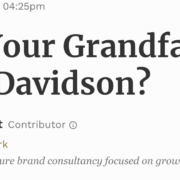The phrase “Be a runway, not a control tower” popped up a few of years ago in a Singapore newspaper. The phrase is a great way to put a frequent brand organization occurrence: the resistance to change.
For brands to be successful in the ongoing challenge to remain contemporary, the idea is not to oppose change but to drive it. Change happens all the time. Today it is almost impossible to keep aware of everything that changes around your brand. The digital advertising business has to deal with technologies, devices, and apps that change so much faster than people adopt and adapt.
Yet, opposition to change happens. Employees may fear how change will alter their jobs. They may think that what has been the current methods of operation should continue to be the standard operating procedure. Or, they are very happy and complacent and see no need to change.
Change initiatives usually come with a detailed program, an HR course, a set of slides, a video, a script, an app, a dictionary, a metric (or series of metrics), out of-office seminars, and in many cases a slew of young, junior consultants who take up a lot of office space. For many brands with change in leadership there is also a change initiative: new person, new ideas.
A brand’s culture sometimes can be the control tower keeping everyone on course, and focusing on avoiding any and all risk. Brands flourish in supportive organizational cultures. If the organization is risk averse or closed to change, it creates an inflexible and relevancy-resistant environment.
Brands must stay relevant. This requires change. Continuing to do the same old things when the world is dynamic is a formula for failure. The biggest challenge that brands face is ensuring that brand teams are open to change, and that the organizational environment is conducive to change. In organizations undergoing change, for that change to be genuine and not superficial, cultural change initiatives must be consistently reinforced, widely communicated, supported from the top of the organization, and realistic for the organization’s current situation.
Brands are dynamic, active promises about what they will do for the customer. Brands do not do well where the control tower effect is in place. Brands need continuous renewal. Brand teams must be aware and alert to marketplace changes and anticipatory ideas for satisfying customer needs. With too much control tower, without the continuous renewal of innovation or renovation, a brand will stagnate. The business will stagnate. Enduring profitable growth requires building a continuous renewal cycle.
When there is a misalignment and conflict between the brand strategy and the brand culture, the culture prevails over the strategy. Culture always wins. Brands need supportive, flexible cultures. If the culture is inactive and risk averse, in other words, a control tower closed to change, the misalignment is serious.
Brands need the runway. But, this does not mean there are no brand boundaries. Every runway is a well-defined pathway. Skidding off the runway is no good. Taxiing outside the boundaries of the runway is dangerous. Staying within the lane but being able to have change take flight is in a brand’s best interests.


